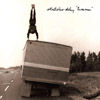Vladislav Delay, "Tummaa"
 On this first release in nearly 2 years, Finnish artist Sasu Ripatti allows a greater amount of his former life as a jazz drummer to enter the fray, offsetting the digital ambience and chaos of his work with a greater sense of the organic, bringing with him Lucio Capece on reeds and Craig Armstrong on piano. The result isn’t quite the jazz trio sound the lineup would suggest but certainly a more natural sound than other releases in the Delay discography.
On this first release in nearly 2 years, Finnish artist Sasu Ripatti allows a greater amount of his former life as a jazz drummer to enter the fray, offsetting the digital ambience and chaos of his work with a greater sense of the organic, bringing with him Lucio Capece on reeds and Craig Armstrong on piano. The result isn’t quite the jazz trio sound the lineup would suggest but certainly a more natural sound than other releases in the Delay discography.
The disc opens with the slow elongated reverberations of “Melankolia,” which layers distant thumping rhythms and erratic scatter-shot digital beats with spacious electronic textures. The string pluck sounds and jazzy club piano music sit above the dissonant electronic stuff in a stark contrast. “Kuula (Kiitos)” buries the organic sounds amongst a significant amount of processing, collage type sounds are intertwined with isolated, sporadic rhythms and the occasional bit of overt, sparse ambience.
“Mustelmia” and “Toive” both stand out as being more percussion focused pieces. The former is based on rhythms that sound as if they were played deep under water along with some faux didgeridoo textures. The entire piece feels like a pseudo-ethnic track, even with the wet pitch-bent drums and spaced out passages. “Toive” has more of a marching cadence to the drums, recorded far off in the distance. The track as a whole has this feeling of distance, with muffled moaning sounds and instrumentation that seems just out of reach, with only clarinet and echoed keyboards to actually be the sounds in focus.
As the disc begins to draw to its inevitable conclusion, the sounds become even more abstract and experimental. “Tummaa” is a dramatic piece that focuses even more on the abstract textures that characterized the earlier Vadislav Delay releases, dynamically being much more loud and boisterous than the other more subtle tracks. A crystalline synth and arctic ambience balance out the loudness with a sense of delicate isolation. The closing “Tunnelivisio” is the most chaotic moment here, with harsher synth leads and garbled saxophone. The delayed, clattering percussion adds to the dissonance, which for all its chaos still has a warm, inviting quality to it.
The shift towards including more of Ripatti’s jazz background has been a smooth one here, as there doesn’t seem to be any unnecessary force needed to blend the organic with the digital. Tummaa is an album that sounds like no one else, and its dark, yet inviting introverted nature ensures that multiple listenings are required to get the full complex beauty of what is here.
samples:



